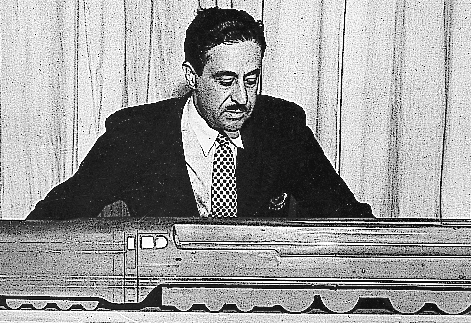


Raymond Loewy
An American Industrial Designer
(1893 - 1986)
To a degree unequaled by the names of any of the other founding fathers of industrial design, the name of Raymond Loewy radiate a charisma that has attracted public attention throughout the past half century. Loewy's flamboyant lifestyle has included at various times country homes outside Paris, in southern France, Mexico, Long Island, and Palm Springs, as well as luxurious urban apartments in Manhattan and Paris. The worldwide image has been reinforced by his design offices not only in New York, Chicago, and Los Angeles, but also in London, Paris, San Juan, and Sao Pauli, among others.James M AlexanderThis matter of image and style is very important because - in combination with a keen business sense, a highly developed imagination, and a rich design talent - it was an important element in generating a sense of excitement about, not only Raymond Loewy, but the new profession of industrial design itself.
Much has been written about the trial by fire the new profession underwent during the Great Depression and how industrial design proved itself by demonstration that in a shrinking market, the product "designed" by an industrial designer would win out over an otherwise similar and equal product. The office of Raymond Loewy provided more than it's share of such demonstration cases - and did so with a flair that reflected credit on the client, firm and designer alike.
Loewy's design philosophy is not a deeply intellectual one. He summarized it with the acronym MAYA (most advanced, yet acceptable). The proliferation of clean, functional, and dynamic products that emerged from the Loewy offices throughout his long career provides testimony to his success in correctly making the prediction "Most advanced, yet acceptable".
Examples of his designs that have become famous include the 1947 Studebaker Starlight Coupe, the 1953 Starliner Coupe and the 1961 Avanti - designs that generated a public interest and acceptance far out of proportion to the company's relative size in the industry; the 1947 line of Hallicrafter radio receivers that conveyed a crisp precision far ahead of their time; the 1929 Gestetner duplicating machine, the S-1 Steam locomotive for the Pennsylvania Railroad - all landmark designs that were extremely successful and influential in establishing higher design standards in their respective design areas.
It is difficult to mesure precisely Loewy's impact on our contemporary environment, but he has certainly had a dynamic and significant one. His continuing vitality and international influence are demonstrated by his being retained as a major industrial design consultant in the 1970's by the Government of the Soviet Union - this as he entered his eighties.